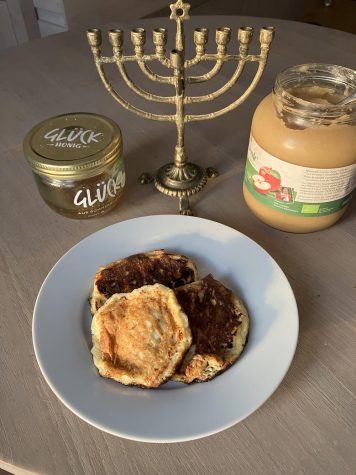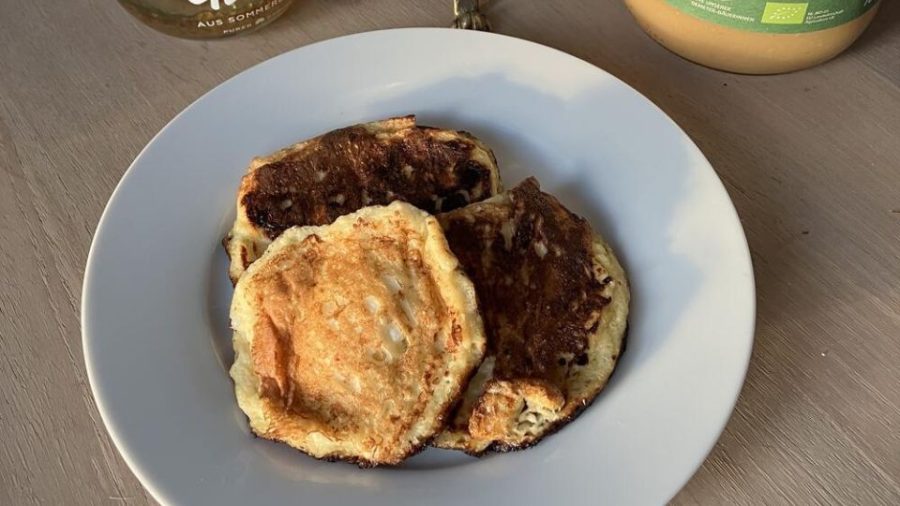Try these cheese latkes for night #3 of Hanukkah
Published December 19, 2022
In the weeks before Hanukkah last year, I began to see stories circulating about “cheese latkes.” The rumor was that, before potatoes, latkes were cooked with cheese. This might seem a bit scandalous to your average modern Jew—potato latkes are, for me at least, an essential part of the holiday season. But as a lover of all things cheese-related, I decided to investigate. What I’ve found is a story about migration, biblical feminism, and colonialism, all of which have shaped how we approach the Festival of Lights today.
If you’ve celebrated Hanukkah before, you likely know that one way we observe the holiday is by eating foods fried in oil— potato latkes and sufganiyot (jelly doughnuts) are most popular—to commemorate the story of the Maccabees, and the temple oil that lasted eight days and nights when it should only have lasted one. A lesser-known Hanukkah custom is to eat dairy, to celebrate the heroism of Judith, slayer of the general Holofernes. Although Judith’s defeat of Holofernes took place centuries before the Maccabees defeated the Romans, Jews in the medieval period began to associate Judith’s bravery with the miracle of Hanukkah.

ADVERTISEMENT
The first official source to mention Judith in association with Hanukkah is Kol Bo, a collection of legal codes that dates to the thirteenth or fourteenth century. Kol Bo states that women, alongside men, are obligated to light Hanukkah candles, because when our enemies came to destroy us, “a great miracle occurred through a woman.” The text says that “[Judith] fed [Holofernes] a dish of cheese to make him thirsty, so that he would drink a great deal and become drunk and recline and fall asleep. And it happened just that way, and once he was asleep, she took his sword and cut off his head. She brought his head to Jerusalem, and when the armies saw that their leader had been killed, they fled. For this reason, we have the custom of eating a cheese dish on [Hanukkah].”
Cheese latkes also appear in fourteenth-century records from southern France/ northern Spain. The cheese pancakes became particularly popular in Italy in the sixteenth century, after many Spanish Jews had migrated from Sicily to northern cities like Vienna and Rome.
But while there are clear associations between Hanukkah and dairy foods, it’s a bit of a stretch to claim that cheese latkes were the predecessors of potato latkes. Frying cheese latkes in oil would have been rather easy in late medieval/early modern Mediterranean cities, where oil was easy to come by. In northern and eastern European countries, however (where most Jews had migrated to during the medieval period, following a series of expulsions), getting a hold of oil was much more difficult and expensive. A more common way to cook food was with schmaltz, a fat produced from excess chicken tissue. Since schmaltz is a meat byproduct, it can’t be used to cook with dairy, according to the laws of kashrut. Eastern European dishes that were eaten around Hanukkah to honor Judith may have included dairy kugel or blinis, a popular eastern European dish of pancakes stuffed with sweet cheese. When cooking with schmaltz, fried buckwheat pancakes may have been a non-dairy substitute for cheese latkes—at least until the arrival of the potato.
At the same time that Spain was expelling Jews, Spanish colonists were beginning their first endeavors into the Americas. These invasions were devastating to the local indigenous populations—and are the reason we are familiar with many popular foods today. While the Spanish invaders didn’t stay long for their first few trips into South America, they quickly discovered types of food that only grew on the American continents—namely tomatoes, corn, and potatoes.
ADVERTISEMENT
The potato took a while to spread throughout Europe. The popularity of the root vegetable grew slowly in Spain, but ultimately found its place in Ireland in the late sixteenth century. Over the next several hundred years, the potato migrated eastwards, eventually reaching the Pale of Settlement in the eighteenth century. Potatoes quickly became popular because they were so cheap and easy to grow. The vegetable also paired well with schmaltz. By the nineteenth century, potato latkes were well established in shtetl culture.
While potato latkes have become one of the most popular foods for celebrating the Hanukkah miracle, dairy remains central within some traditions. For Ashkenazi Jews, kugel and blinis are very popular at Hanukkah time. In Italy, ricotta pancakes called cassola are still considered a Hanukkah delicacy. And Jews of Indian descent eat gulab jamun, a sweet made from a milk-based dough that is rolled into balls, fried in oil, and soaked in a sugary syrup.
Maybe you’d like to add a dairy dish to your usual holiday meal this season and take time to honor Judith’s miracle, in addition to the Maccabees’. There are many great recipes out there to choose from, but I decided to see if I could create my own (a great excuse to indulge in many nights of cheese pancakes). Here’s what I’ve come up with:
Cheese Latkes
Makes 12-16 pancakes
Ingredients:
- 1 cup farmer’s cheese (use ricotta for a creamier texture)
- 2 eggs
- 2 tbsp honey
- ½ tsp salt
- ¼ tsp baking powder
- ¼ cup wheat flour (all-purpose is fine, but you might need an extra tbsp)
- Oil for frying
- Applesauce/honey for serving
Directions:
- Whisk together the cheese and eggs. Add in the honey.
- Mix together the salt, baking powder, and flour. Fold the flour mixture into the wet ingredients
- Heat a generous amount of oil in a pan. Use a spoon to scoop the pancake mixture into the pan. Cook on low heat for about 4-5 minutes each side. The pancake should bubble up a little bit like a regular pancake.
- Serve with applesauce or honey (or a sweet fruit of your choice)
Happy Hanukkah!
















